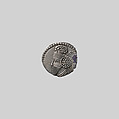Drachm
Not on view
Numismatists – the scholars who study coins – refer to the ‘front’ side of the coin, which usually features the head of a person or god, as the ‘obverse,’ and the ‘back’ side as the ‘reverse.’
On the obverse of this silver coin, a bust of the king faces to the left. He has a long beard rendered with vertical lines, and wears a diadem (the headband worn by victorious athletes in ancient Greece). He also wears a torque or necklace around his neck. He has curly hair, rendered as two circular groups of dots, one of top of his head and the other at the back of his head. His large eye is represented by a raised dot between two thick lines which serve as his eyelid. A border of dots surrounds the image.
The reverse shows a seated man facing right. He wears striped sleeves and trousers under a cloak, as well as a diadem, of which only the ends are visible at the back of his head. In his hand he holds a bow with the bowstring upwards. A cross and horizontal line beneath him and a vertical line bisected four times seem to represent a high-backed throne on which he is seated. In front of him is a monogram, perhaps containing the Greek letters A and T; this may indicate that the coin was minted at Ecbatana (modern Hamadan, in western Iran). A largely illegible Greek inscription surrounds the man. On the basis of the recognizable letter forms and comparison with inscriptions on earlier Parthian coins, it is probably intended to read "of the king of kings Arsaces the generous, just, renowned and Greek-loving."
This coin was struck by the Parthian king Osroes (reigned ca. A.D. 110-129?). The king on the obverse is probably meant to be Osroes himself, wearing a diadem as a symbol of victory. The identity of the figure on the reverse is unknown; perhaps it is an idealized Parthian king, depicted as an archer. The figure of the archer is quite stylized, in contrast to earlier Parthian coins where it is more closely modeled on the image of Apollo that appears on early Seleucid coins. The head of the king on the obverse also exhibits some stylization, such as in the schematic rendering of the eye and beard. It seems that sometime during the first century A.D. the Parthians rejected Seleucid stylistic models altogether, in favor of this more schematic rendering.
The inscription on the reverse is almost entirely illegible, as are most inscriptions on Parthian coins after ca. A.D. 100. If interpreted correctly, this inscription names the first ruler of the empire Arsaces I (reigned ca. 247–217 B.C.), rather than the current ruler. It may be a reference to the dynasty founded by Arsaces, or perhaps the seated archer is meant to represent him. It is also possible that all Parthian kings were called ‘Arsaces’ as a title or throne name.
Due to rights restrictions, this image cannot be enlarged, viewed at full screen, or downloaded.
This artwork is meant to be viewed from right to left. Scroll left to view more.



